Fiches poissons d'eau douce (page 11)
Page 11 des 1910 espèces de poissons d'eau douce avec 60 fiches. Il y a 23 genres différents de Corydoras à Cyprinus.
Liste des fiches de Corydoras semiaquilus à Cyprinus carpio
- Corydoras semiaquilus

6,0 → 8,0 cm (> 200 L)
pH 5,0–7,5 | GH 1–8 | 22–26°C - Corydoras septentrionalis

5,5 → 6,5 cm (> 120 L)
pH 5,0–7,0 | GH 1–8 | 21–28°C - Corydoras similis

3,5 → 5,5 cm (> 80 L)
pH 5,0–7,0 | GH 1–8 | 21–27°C - Corydoras simulatus

4,5 → 6,0 cm (> 80 L)
pH 5,5–7,5 | GH 1–15 | 20–25°C - Corydoras sodalis
 Corydoras à faux réseau
Corydoras à faux réseau
4,0 → 5,0 cm (> 80 L)
pH 6,0–7,5 | GH 2–25 | 22–26°C - Corydoras solox

5,8 → 6,5 cm (> 120 L)
pH 5,0–7,5 | GH 1–10 | 22–28°C
- Corydoras sp. kristinae C042

6,5 → 7,5 cm (> 200 L)
pH 6,0–7,5 | GH 1–8 | 22–26°C - Corydoras spectabilis
 Corydoras millénium
Corydoras millénium
4,5 → 6,0 cm (> 80 L)
pH 6,0–7,5 | GH 1–10 | 23–27°C - Corydoras spilurus
 Corydoras à gorge rose
Corydoras à gorge rose
5,0 → 6,5 cm (> 120 L)
pH 5,5–8,0 | GH 1–30 | 22–26°C - Corydoras stenocephalus
 C017
C017
6,0 → 6,5 cm (> 120 L)
pH 6,0–8,0 | GH 1–20 | 22–26°C - Corydoras sterbai

6,0 → 7,0 cm (> 120 L)
pH 5,0–7,0 | GH 1–8 | 22–27°C - Corydoras treitlii

5,5 → 7,0 cm (> 200 L)
pH 6,0–8,0 | GH 2–25 | 20–24°C - Corydoras trilineatus
 Corydoras à trois bandes
Corydoras à trois bandes
5,2 → 6,1 cm (> 80 L)
pH 5,5–7,5 | GH 1–12 | 22–26°C - Corydoras venezuelanus var. Orange

4,5 → 5,5 cm (> 80 L)
pH 6,0–7,0 | GH 1–8 | 19–25°C - Corydoras vittatus

3,6 → 6,0 cm (> 80 L)
pH 6,0–7,5 | GH 2–12 | 22–26°C - Corydoras zawadzkii

3,5 → 5,0 cm (> 80 L)
pH 5,0–6,5 | GH 1–8 | 22–27°C - Corynopoma riisei
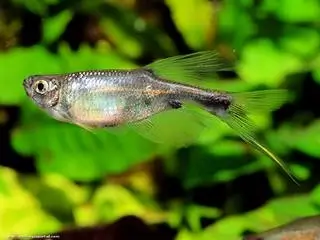 Tétra-xipho
Tétra-xipho
4,2 → 4,8 cm (> 120 L)
pH 6,0–7,5 | GH 1–12 | 22–28°C - Crenicara punctulata
 Cichlidé à damier tacheté
Cichlidé à damier tacheté
10,0 → 12,0 cm (> 300 L)
pH 5,0–6,5 | GH 1–5 | 23–27°C - Crenicichla gillmorlisi
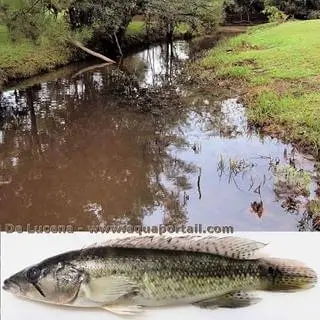
10,0 → 18,0 cm (> 300 L)
pH 5,0–6,5 | GH 1–5 | 23–27°C - Crenicichla lucenai

10,0 → 14,5 cm (> 120 L)
pH 5,5–7,0 | GH 1–10 | 22–28°C - Crenicichla taikyra

10,0 → 12,0 cm (> 200 L)
pH 6,5–7,5 | GH 3–10 | 24–29°C - Crenicichla ypo
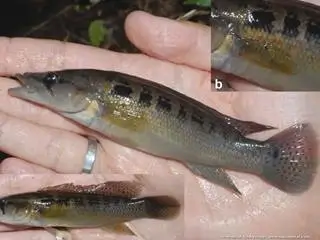
10,0 → 14,0 cm (> 200 L)
pH 5,5–7,0 | GH 1–8 | 23–27°C - Crenuchus spilurus
 Tétra voilier
Tétra voilier
5,5 → 6,0 cm (> 50 L)
pH 5,0–6,5 | GH 1–5 | 23–29°C - Cribroheros alfari
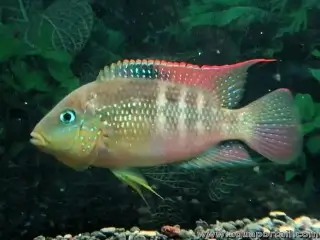 Cichlidé pastel
Cichlidé pastel
13,0 → 16,0 cm (> 450 L)
pH 6,5–7,5 | GH 3–10 | 20–34°C
- Cribroheros altifrons
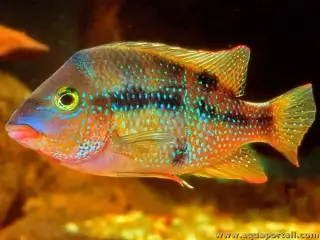
10,0 → 13,0 cm (> 800 L)
pH 7,0–7,5 | GH 8–20 | 22–29°C - Cribroheros bussingi

13,0 → 16,0 cm (> 450 L)
pH 6,5–7,5 | GH 5–12 | 23–26°C - Cribroheros diquis
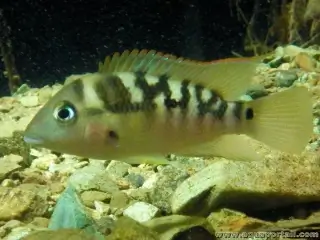
11,0 → 14,0 cm (> 800 L)
pH 7,0–8,0 | GH 5–20 | 23–33°C - Cribroheros longimanus
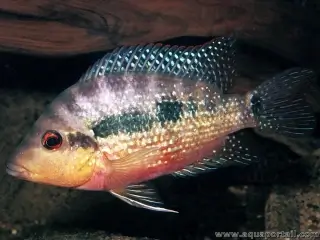 Cichlidé à poitrine rouge
Cichlidé à poitrine rouge
11,0 → 15,0 cm (> 450 L)
pH 7,0–8,0 | GH 5–20 | 23–36°C - Cribroheros rhytisma
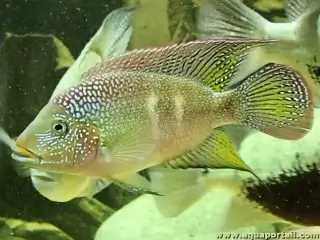 Cichlidé perlé
Cichlidé perlé
12,0 → 14,0 cm (> 450 L)
pH 6,5–7,5 | GH 5–15 | 24–26°C - Cribroheros robertsoni
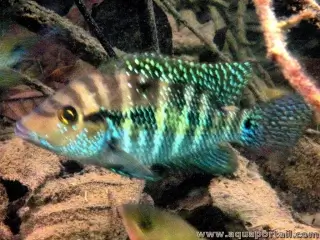 Cichlidé émeraude
Cichlidé émeraude
17,0 → 20,0 cm (> 800 L)
pH 7,0–8,0 | GH 5–20 | 26–30°C - Cribroheros rostratus

16,0 → 20,0 cm (> 800 L)
pH 7,0–8,0 | GH 5–20 | 24–30°C - Crossocheilus nigriloba

12,0 → 15,0 cm (> 300 L)
pH 6,0–7,5 | GH 3–15 | 22–25°C - Crossocheilus oblongus
 Mangeur d'algues siamois, barbeau à raie noire
Mangeur d'algues siamois, barbeau à raie noire
12,0 → 16,0 cm (> 300 L)
pH 5,5–8,5 | GH 1–30 | 23–26°C - Crossocheilus reticulatus
 Barbeau réticulé
Barbeau réticulé
15,0 → 17,0 cm (> 450 L)
pH 6,5–7,5 | GH 5–12 | 22–26°C - Cryptoheros cutteri
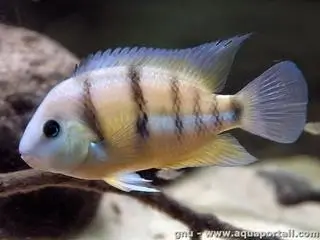
10,0 → 13,0 cm (> 200 L)
pH 6,0–7,5 | GH 1–10 | 21–27°C - Cryptoheros spilurus
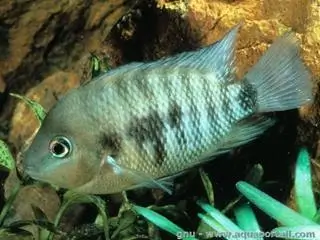 Cichlidé aux yeux bleus
Cichlidé aux yeux bleus
8,0 → 12,0 cm (> 200 L)
pH 6,0–7,5 | GH 3–12 | 22–32°C - Ctenobrycon hauxwellianus

7,5 → 8,2 cm (> 300 L)
pH 5,5–7,0 | GH 3–8 | 20–27°C - Ctenobrycon spilurus
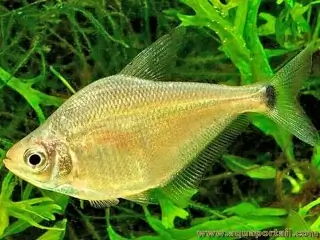 Tétra argenté
Tétra argenté
6,5 → 8,0 cm (> 200 L)
pH 5,5–7,0 | GH 3–8 | 21–27°C - Ctenopoma weeksii
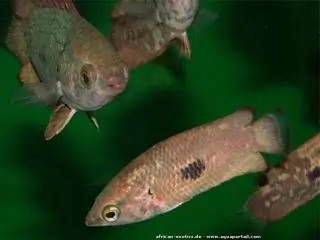 Anabas oxyrhynchus
Anabas oxyrhynchus
10,0 → 12,0 cm (> 120 L)
pH 6,0–7,5 | GH 3–12 | 24–28°C - Ctenops nobilis
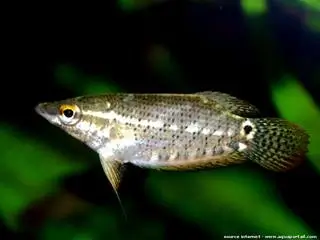 Gourami fragile
Gourami fragile
9,0 → 10,0 cm (> 120 L)
pH 6,0–7,5 | GH 1–12 | 20–24°C - Cunningtonia longiventralis

12,0 → 15,0 cm (> 450 L)
pH 7,5–8,5 | GH 10–20 | 23–28°C - Cyanogaster noctivaga

1,4 → 1,6 cm (> 50 L)
pH 5,0–6,0 | GH 1–3 | 24–26°C - Cyathochromis obliquidens
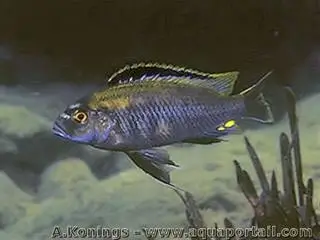
12,0 → 15,0 cm (> 300 L)
pH 7,5–8,5 | GH 10–25 | 23–27°C - Cyathopharynx furcifer

18,0 → 21,0 cm (> 450 L)
pH 7,5–8,5 | GH 10–25 | 23–27°C - Cynodonichthys tenuis
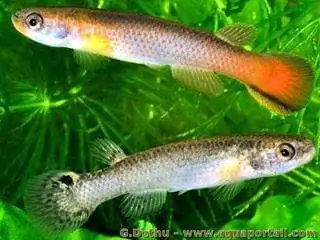
5,0 → 6,5 cm (> 20 L)
pH 6,0–7,0 | GH 3–8 | 22–28°C - Cynopoecilus melanotaenia

2,6 → 5,0 cm (> 50 L)
pH 5,0–6,5 | GH 1–5 | 18–24°C - Cynotilapia afra

9,0 → 11,0 cm (> 450 L)
pH 8,0–9,0 | GH 10–25 | 23–27°C - Cynotilapia aurifrons
 Cynotilapia sp. Mbamba
Cynotilapia sp. Mbamba
6,5 → 7,5 cm (> 450 L)
pH 7,5–8,5 | GH 10–20 | 22–28°C - Cynotilapia axelrodi
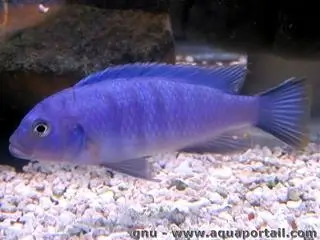
7,0 → 9,0 cm (> 200 L)
pH 7,5–8,5 | GH 10–25 | 23–27°C - Cynotilapia chilundu
 Pseudotropheus sp. Elongatus Taïwan
Pseudotropheus sp. Elongatus Taïwan
6,0 → 8,3 cm (> 450 L)
pH 7,5–8,5 | GH 10–20 | 23–26°C - Cynotilapia zebroides
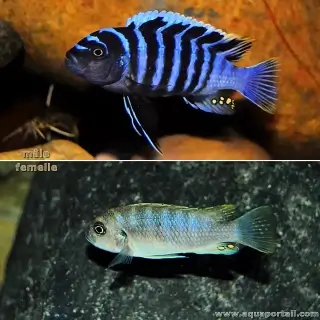
7,5 → 9,3 cm (> 450 L)
pH 7,5–8,5 | GH 10–20 | 23–26°C - Cyphotilapia frontosa
 Cichlidé Napoléon
Cichlidé Napoléon
25,0 → 35,0 cm (> 800 L)
pH 7,5–8,5 | GH 10–30 | 23–28°C - Cyphotilapia gibberosa
 Cypho à tête noire, Cypho à 5 barres
Cypho à tête noire, Cypho à 5 barres
20,0 → 28,0 cm (> 800 L)
pH 7,5–8,5 | GH 10–25 | 22–25°C - Cyprichromis microlepidotus

6,0 → 9,0 cm (> 300 L)
pH 7,5–8,5 | GH 10–30 | 23–25°C - Cyprinella lutrensis
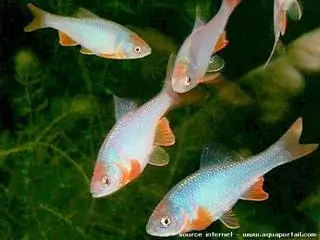 Cyprin américain à nageoires rouges
Cyprin américain à nageoires rouges
8,0 → 9,0 cm (> 300 L)
pH 7,0–7,5 | GH 10–20 | 15–25°C - Cyprinella venusta
 Méné à queue noire
Méné à queue noire
10,0 → 20,0 cm (> 450 L)
pH 6,0–7,5 | GH 3–15 | 18–22°C - Cyprinodon desquamator

2,5 → 3,1 cm (> 50 L)
pH 8,0–9,0 | GH 20–30 | 24–30°C - Cyprinodon macularius
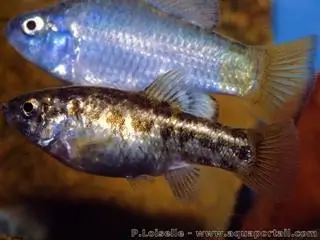 Poisson mordeur du désert
Poisson mordeur du désert
4,0 → 7,2 cm (> 80 L)
pH 5,0–9,0 | GH 3–20 | 4–45°C - Cyprinus acutidorsalis
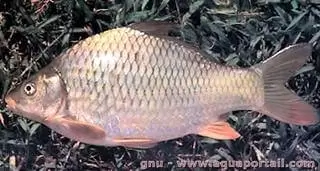
25,0 → 30,0 cm (> 1500 L)
pH 6,0–8,0 | GH 5–25 | 12–24°C - Cyprinus carpio
 Carpe commune, carpe miroir, carpe cuir, carpe koï
Carpe commune, carpe miroir, carpe cuir, carpe koï
40,0 → 80,0 cm (> 1500 L)
pH 6,5–9,0 | GH 5–30 | 5–25°C
Les données biologiques des espèces indiquent la taille en cm et, si les valeurs sont pertinentes, d'autres caractéristiques spécifiques.
